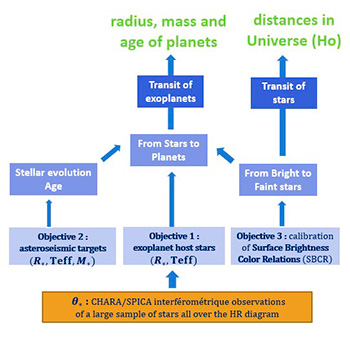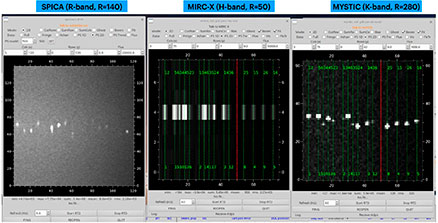Framework
Fundamental stellar parameters are the primary data required for an in-depth understanding of stars, their interiors, and their environments. With the progress of stellar physics and the prospects of ground facilities or space missions, it is critical to improve the accuracy, and quantity of such data. The development of exoplanet and asteroseismology domains is demanding direct data to eliminate any bias in the parameters. And finally, the differences between methods for determining the Hubble constant is motivating new and precise direct determination of distances on the primary candles of the cosmic scales. Many methods like asteroseismology, photometric transits of exoplanets, radial velocities, or Surface Brightness Colour (SBC) relations are linked to the stellar radius. Usually estimated through models, its determination by coupling an optical interferometric measurement of the angular diameter and, for example, a Gaia parallax, is the best way to avoid any model dependence. Furthermore, characterizing any activity (limb darkening, convection, rotation, spots, or binarity) is also mandatory, both for bias removal and for the required progress on stellar physics.
Method
 Through an ambitious and homogenous survey of the angular diameters of a thousand stars as faint as magnitude 8 in the visible and as small as 0.2 milliseconds of arc, our project is built to address key questions about the relation between planets and stars and to offer to the broader community a unique and primary source of direct information on a representative and large sample of stars all over the HR diagram. A few hundred of direct measurements of limb darkening will be accessible, and, for about 100 stars, activity characterization with a more detailed surface imaging will be possible. These data will also permit the development of new unbiased SBC relations to serve the faint targets of space missions like PLATO or ARIEL in the future and the distance scale within the Araucaria project.
Through an ambitious and homogenous survey of the angular diameters of a thousand stars as faint as magnitude 8 in the visible and as small as 0.2 milliseconds of arc, our project is built to address key questions about the relation between planets and stars and to offer to the broader community a unique and primary source of direct information on a representative and large sample of stars all over the HR diagram. A few hundred of direct measurements of limb darkening will be accessible, and, for about 100 stars, activity characterization with a more detailed surface imaging will be possible. These data will also permit the development of new unbiased SBC relations to serve the faint targets of space missions like PLATO or ARIEL in the future and the distance scale within the Araucaria project.
Working Plan
The first year of the ERC project will allow the optimization of the CHARA/SPICA instrument: commissioning, pipeline performance and survey management. The four remaining years will be obviously dedicated to the execution of the survey, the data analysis, and the development of the exploitation tools. This will give the keys for producing the science results over the four main astrophysical goals:
- Radius and Effective Temperature of a large sample of exoplanet host stars
- Observation of a large and homogeneous sample of asteroseismic and interferometric targets
- Calibration of new SBC relations
- Markers of activity through intensity profile and surface structure
The project is organized around three main tasks
- Task A Pipeline performance and survey management (T0 - T0+12m): The data reduction pipeline, based on the one developed for FRIEND, will have to be fully automated. Special care will be used on the analysis of the calibrators to measure the transfer function, and to produce the calibrated data. Reaching 1° on the closure phase and 1% on the squared visibility is possible considering what has been achieved with FRIEND and the performance of SPICA. The commissioning will help us to understand and correct the systematics, and to optimize the instrument and the pipeline before the start of the survey. Based on the input catalog and the choice of calibrators, one task will be devoted to the night scheduling. Conducting a Large Program of this scale in optical interferometry is totally new, larger by a factor 10 in number of targets. With a conservative estimation of 20 science targets per night and 70 nights per year, one can reach about 4000 observations in 3 years. This will permit us to achieve my goals in the different samples of the catalog with some revisits for multiplicity follow-ups or observations done to improve the (u,v) coverage. Managing the survey means also considering a careful follow-up of any observation. A quality control and data validation system will be developed based on the output of the pipeline. The night strategy will use primary calibrators that will be observed during different nights to improve the global calibration of the data.
- Task B Conducting the survey, quality criteria, science production. (T0+12m – T0+60m): For conducting the observations after 2022, I will implement the same kind of automatic scheduling as the one used between the interferometric preparation tool ASPRO2 and the control software of VLTI: the A2P2 python software. I am considering sequences of 15mn, leading to 30 to 50 stars depending on the night length. The data will be ready for science analysis and will be protected by a proprietary period adapted to the overall goal of the project based on the global collection of measurements. Obviously, individual results of importance will be used for fast publication. Preparation of the exploitation tools is mainly based on the existing tools that the interferometric and the stellar physics communities have developed in the last decades. The core of this work package is to gather, test and validate all the codes that will be necessary for fitting directly intensity profiles from atmosphere models, spectral energy distributions, and models of evolution for extracting mass and age of the targets.
- Task C Scientific exploitation of the survey. (T0+12m – T0+60m): Many programs will be possible and managed during this 4-year period of the ERC project. Having guaranteed the access to the correct number of nights, my plan is to focus my research on the four major topics presented at the beginning.The work of the postdocs team that I plan to buikd will be at the core of the CHARA/SPICA large program, on complementary aspects. Through their engagements under my supervision, they will serve these major science objectives. Their work will also serve the community at large through the legacy value of this research and, more pragmatically also, through the tools we will develop together.





